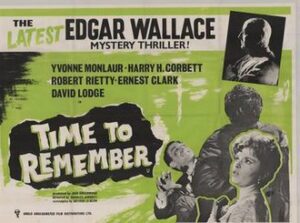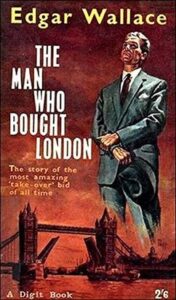Time To Remember ** (1962, Yvonne Monlaur, Harry H Corbett, Robert Rietty) – Classic Movie Review 13,330
Harry H Corbett stars in the 1962 Edgar Wallace Mysteries crime film Time to Remember as a shady estate agent who seizes the chance to recover stolen loot after a jewel robbery goes wrong at an empty London house.
Director Charles Jarrott’s 1962 British Edgar Wallace Mystery series crime film Time To Remember stars Harry H Corbett, Yvonne Monlaur, Robert Rietty, Ernest Clark, David Lodge, and Ray Barrett. It is written by screen-writer Arthur La Bern, loosely based on Edgar Wallace’s 1915 novel The Man Who Bought London, and is part of the 48-film Edgar Wallace Mysteries series of second-feature films made at Merton Park Studios, released in British cinemas between 1960 and 1965.
Harry H Corbett returns from the 1960 film Marriage of Convenience for another intriguing if minor Edgar Wallace Mysteries filler thriller. Corbett stars as Jack Burgess, a shady, opportunistic real estate agent who seizes the chance to recover stolen loot after a jewel robbery goes wrong at an empty London house.
A gang of jewel thieves rob a large London house which has just become empty after the death of its rich lady owner. The robbery goes wrong and one of the gang, Jumbo Johnson (David Lodge), climbs to the roof and throws the jewels down one of the chimneys as he’s about to be captured by the police, and then falls off the roof, while another, Victor (Robert Rietty), makes off back to Paris with the equally valuable stamp collection.
Jumbo tells his wife about the loot he’s hidden and she tries to buy the house from dodgy estate agent Burgess (Harry H Corbett), who becomes suspicious, gets the keys to the house, works out the chimney idea, and finds the jewels hidden behind the plastered up fireplace. But the wife, gang member Sammy (Ray Barrett) and Victor are after the jewels too…
There’s a good, more than serviceable, if far-fetched plot here but the film is rather stagey and unconvincing with one or two quite dodgy, off-key performances, notably unfortunately those of the two stars Yvonne Monlaur and Harry H Corbett, and also Andre Charisse as the French policeman Inspector Charcot. These don’t feel like authentic characters at all, though, to be fair, Corbett is very entertaining.
On the other hand, Robert Rietty as Victor, Ernest Clark as rival estate agent Cracknell, David Lodge as Jumbo Johnson, Ray Barrett as the getaway driver Sammy and Jack Watson as Inspector Bolam are all just fine in truthful performances.
The snowy London outside shooting also helps, with impressively precarious scrambling about on the house’s rooftops. There’s a little bit of tension and excitement in places as the characters scheme and the complicated plot unravels. And, thanks to the enormous amount of plot to get through in 58 minutes, it moves very swiftly indeed, perhaps too swiftly for comfort or coherence, despite oddly contrived pauses for chat and humour. So it is painless and has its charms but is undistinguished.
It is the final film of Brenda Kaye (as secretary).
Just to be clear, the opening credits state: ‘All characters and events in this film are fictitious and any similarity to actual persons and events is purely coincidental.’ Also in the opening credits, Ray Barrett’s name appears last as ‘… and introducing Ray Barrett’.
The low budget is visible when the scene outside the windows of Burgess’s office is so obviously just a painted backdrop. It looks suspiciously like the view across the Thames usually seen from a Scotland Yard window in the series.
The films were later sold to American TV and screened as The Edgar Wallace Mystery Theatre. Time to Remember was released by Anglo-Amalgamated in July 1962.
Charles Jarrott’s films also include: Anne of the Thousand Days (1969), Mary Queen of Scots (1971), Lost Horizon (1973), The Dove (1974), The Other Side of Midnight (1977), Escape from the Dark [The Littlest Horse Thieves] (1977), The Last Flight of Noah’s Ark (1980), Condorman (1981), The Amateur (1981).
The cast
The cast are Yvonne Monlaur as Suzanne, Harry H Corbett as Jack Burgess, Robert Rietty as Victor, Ernest Clark as Cracknell, David Lodge as Jumbo Johnson, Ray Barrett as Sammy, Patricia Mort as Vera, Genine Graham as Mrs Johnson, Jack Watson as Inspector Bolam, Andre Charisse as Inspector Charcot, Larry Taylor as Garritty, Brenda Kaye as secretary, Marjie Lawrence as Vivienne, Brian Hewitt-Jones as police constable, Peter Howard-Johnson as police sergeant, Pat Gorman as police constable, and John Tatum as plain-clothes policeman.
British writer Edgar Wallace’s 1915 crime novel The Man Who Bought London was first filmed in 1916 as a British silent, the first of Wallace’s many film adaptations.
In Wallace’s original, different story, rich American Kerry King heads a syndicate of millionaires buying large chunks of London to redevelop them for poorer folk, but he is thwarted by former business partner Hermann Zeberlieff.
It was first filmed as a 1916 British silent starring Evelyn Boucher and Roy Travers, the first of Wallace’s film adaptations.
Arthur La Bern (1909–1990)
Arthur La Bern (1909–1990) had four of his novels adapted into films, including Goodbye Piccadilly, Farewell Leicester Square (1966), which was made into Alfred Hitchcock’s Frenzy (1972).
La Bern wrote a frenzied letter to the editor of The Times complaining about Hitchcock’s Frenzy:
Letters to the Editor
Hitchcock’s “Frenzy”, from Mr Arthur La Bern
Sir, I wish I could share John Russell Taylor’s enthusiasm for Hitchcock’s distasteful film, Frenzy (review, May 24). I endured 116 minutes of it at a press showing and it was, at least to me, a most painful experience.
I do speak with some authority on this subject. It so happens that I am the author of the novel, Goodbye Piccadilly, Farewell Leicester Square, on which the film was based.
Mr Hitchcock employed Mr Shaffer to adapt my book for the screen, apparently because of the latter’s successful stage play, Sleuth.
The result on the screen is appalling. The dialogue is a curious amalgam of an old Aldwych farce, Dixon of Dock Green and that almost forgotten No Hiding Place. I would like to ask Mr Hitchcock and Mr Shaffer what happened between book and script to the authentic London characters I created.
Finally : I wish to dissociate myself with Mr Shaffer’s grotesque misrepresentation of Scotland Yard offices.
Yours, etc,
ARTHUR LA BERN,
7 Russell Court,
St James’s, SW1.
© Derek Winnert 2024 – Classic Movie Review 13,330
Check out more reviews on http://derekwinnert.com



